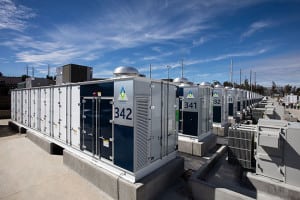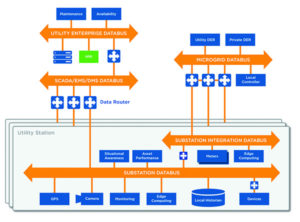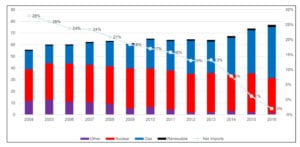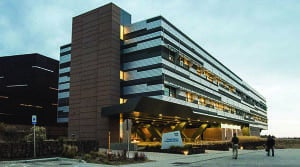DERs
-
Solar
Not Always Plug and Play—Challenges Utilities Face Managing DERs on Their Grids
The proliferation of renewable energy is necessary for communities and countries to meet their goals of reducing carbon emissions, but it also presents new challenges for those managing power distribution. Much of the world’s renewable energy is now generated and stored by distributed energy resources (DERs), such as residential solar panels, batteries, and electric vehicles […]
-
IIOT
Will Cybersecurity Derail the Energy Transition?
Commentary by Jay Zoellner, CEO Kiwi Power. The ransomware attack that forced one of the nation’s largest fuel arteries to halt operations earlier this month exposed critical vulnerabilities in the American energy system, and as the largest such attack in history, it raised serious concerns for the security of our energy infrastructure. Supplying nearly half […]
-
Press Releases
EnergyHub bolsters DERMS platform with Mercury Edge Connect, enabling utilities to integrate with any DER provider
BROOKLYN, N.Y. and San Carlos, CA, February 18, 2021:EnergyHub today announced the release of Mercury Edge Connect, a standardized integration framework for connecting DER providers with EnergyHub’s Mercury DERMS. Mercury Edge Connect allows utilities to manage devices from any DER provider to deliver grid services. The addition of Mercury Edge Connect strengthens the ability of […]
-
Distributed Energy
Partnership’s New Charge—Pair EVs with Utilities, Grid
Integrating electric vehicles (EVs) with the power grid has become a focus for utilities, particularly in areas with large concentrations of EVs. It also is another way for utilities to expand their business models, as they partner with companies involved with charging stations and residential energy storage applications. EnergyHub, a distributed energy resources (DERs) management […]
-
Commentary
FERC Opens Electricity Markets to Distributed Resource Aggregators
By Bud Earley and Mark Perlis, Covington & Burling LLP The Federal Energy Regulatory Commission (FERC) on Sept. 17, 2020, approved a final rule that will enable distributed energy resource aggregators to compete in organized wholesale electricity markets. Distributed energy resources (DERs) are located on the electric distribution system or behind the customer meter and […]
-
Interview
The POWER Interview: Financial Benefits of Energy Storage
Speakers at POWER’s recent Distributed Energy Experience were unanimous in their agreement that energy storage is a game-changing technology for the power generation sector. Storage provides for more reliability and resilience, and already is proving its importance to supporting the growth of solar and wind power. Utilities are incorporating storage into their generation portfolios. It […]
-
Coal
Black & Veatch: No More Coal Construction
Black & Veatch is ending the company’s participation in coal-based power market design and construction, saying it will allow the company to focus on clean energy technologies. The engineering and construction giant’s announcement Oct. 29 comes just more than a month after another major energy company, General Electric, said it would exit the new-build coal […]
-
Press Releases
Electric Power Research Institute Joins Energy Web Strategic Collaboration, Will Test Blockchain Technology for Distributed Resource Integration
Palo Alto, Calif., and Zug, Switzerland — 28 October 2020 — Today the Electric Power Research Institute (EPRI) became the newest member of Energy Web (EW), opening the door for the organizations to work together on open blockchain platforms for integrating distributed resources. The strategic collaboration between the two organizations will include: Drawing upon EPRI’s research […]
-
Distributed Energy
Digital Applications, Data, and the Microgrid User Experience
EnTech Solutions, a sister company of Faith Technologies, was created to provide renewable, resilient energy solutions that enable its partners to control energy costs and reliability and minimize their environmental impact. EnTech utilizes microgrids that leverage proprietary power control hardware, energy management software, energy storage and other distributed energy resources (DERs) to consistently deliver high-value, […]
-
Distributed Energy
Economics Drive Design of DER Systems
Distributed energy systems are transforming the way power is produced and distributed. The decentralized model of power generation, where energy is produced closer to where it will be used, rather than at a large plant elsewhere and sent through the traditional grid, has several advantages, including reducing transmission losses and lowering carbon emissions. An Oct. […]
-
Distributed Energy
Gearing Up for Grid Integration
The growing adoption of distributed energy resources presents another challenge for utilities and grid operators as they design and plan for how electricity is produced and delivered. The past few years have
-
Renewables
The POWER Interview: Are DERs an Opportunity, or Threat?
Distributed energy resources (DERs) are physical and virtual assets that are deployed across the power distribution grid. They are typically close to load, and though they initially began as behind-the-meter assets, today may be as likely to be deployed in front of the meter. DERs include renewable energy, and are the key component in microgrids, […]
-
Distributed Energy
Leveraging the Benefits of Microgrids and DERs
The digitalization of power generation includes many new technologies, all designed to increase efficiency, along with reliability and resiliency. A group of energy industry experts came together Sept. 30 at Experience POWER, the virtual event supported by POWER magazine, to discuss “Microgrids and DERs—Leveraging the Benefits.” The session explored how data analytics and the Industrial […]
-
Interview
The POWER Interview: Adapting to the Use of DERs
Distributed energy resources (DERs) have become a major part of today’s power generation landscape. DERs are physical and virtual assets that are deployed across the grid. They are typically close to load, and can be deployed both in front of and behind the meter. Bill Strohecker, Country Managing Director, Canada, for Hitachi ABB Power Grids, […]
-
News
FERC Order Backs Grid Market for DERs
The Federal Energy Regulatory Commission (FERC) issued an order that advocates for distributed energy resources (DERs) say will enable DERs, including renewable energy such as solar, wind, and battery storage, to compete on a more-level playing field in the organized capacity, energy, and ancillary services markets run by regional grid operators. FERC Order No. 2222, […]
-
IIOT Power
The POWER Interview: Modernizing the Grid with DERs
Energy industry experts have for years talked about the need to modernize the power grid. The focus can be on replacing and upgrading infrastructure, improving the efficiency of power delivery through digitization and smart grid technologies, or on the dispatch of renewable energy resources. Often, it’s all of the above. Industry analysts know that a […]
-
News
NARUC Report Focuses on DERs, Microgrids, and Grid Resilience
The National Association of Regulatory Utility Commissioners (NARUC) has released a report focused on how distributed energy resources (DERs) and microgrids can improve the resilience of the power grid. The report, Advancing Electric System Resilience with Distributed Energy Resources: A Review of State Policies, is designed in part as a guide to help state regulators […]
-
Renewables
Smart Technology Needs Smart Policy: How Market Structures Cripple Climate Solutions
Here’s the good news: humanity knows how to solve climate change. Wind, solar, energy storage, and efficiency technologies are cost-competitive, fully mature solutions that are ready to be deployed everywhere. Wind and solar are now the cheapest forms of new energy to build and continue to get cheaper. COMMENTARY Now the bad news: market inertia […]
-
O&M
The Case for Autonomous Network Management
There is a near-global drive to replace carbon-based, polluting, resource-constrained energy sources with non-carbon renewables as the primary fuel for the electricity industry. Even traditional sources of
-
Press Releases
Scale Microgrid Solutions Announces Equity Commitment of up to $300 Million from Warburg Pincus
Ridgewood, NJ – January 27, 2020 – Scale Microgrid Solutions (“SMS”), a leading distributed clean energy and microgrid platform, todayannounced that it has secured an equity commitment of up to $300 million from Warburg Pincus, a global private equity firm focused on growth investing. Founded in 2016, SMS is a vertically integrated distributed energy company […]
-
Press Releases
New customer portal from Smarter Grid Solutions supports UK and US utility customers
Smarter Grid Solutions (SGS) is rolling out its new Distributed Energy Resources Management System (DERMS) Customer Portal in the US after successful deployment in the UK. SGS invested in its new secure Customer Portal and its Managed Services and Support team to enhance support for its operational utility DERMS customers. Scottish & Southern Energy Networks and UK Power Networks both use the portal […]
-
Commentary
2020 – A New Energy Era Begins, and Storage is Key
This last year of the decade proved to be a pivotal year for energy storage technology, as major developments underscored why it is so vital for energy markets. Events such as widespread power outages and transmission issues on a global scale have led to the precipitous rise in energy storage deployments. The energy industry has […]
-
History
Why the 2010s Were a Definitive Decade for Power
Every one of the 13 decades that POWER magazine has been in print has been definitive for electric generation technology, policy, and business in some significant way, but few have been as transformative as the 2010s. The decade opened just as the global economy began to crawl toward recovery from a historically unprecedented downturn that […]
-
Fuel
NERC: Long-Term Reliability Uncertain Amid Rapid Changes to Bulk Power System
Significant and rapid changes that are reshaping North America’s power sector will likely leave Texas and Ontario, Canada, with supply shortfalls over the next decade, and energy deficiencies could also occur during off-peak conditions in the Midcontinent Independent System Operator (MISO) area and the Western Electricity Coordinating Council (WECC) region, the North American Electric Reliability […]
-
Connected Plant
Empowering Data to Efficiently Build the Connected Grid of the Future
The power industry is witnessing rapid changes thanks to technology. Networks are evolving, and the Industrial Internet of Things (IIoT) has taken root, with autonomous systems contributing to the rise of
-
Fuel
New Jersey’s 100% Clean Energy Goal Imperils Gas Generation
Through a series of incentives and mandates, New Jersey is planning to produce 100% of its power from carbon-neutral sources, electrify its vehicle fleet and building sectors, and set mandatory efficiency standards for electric utilities by 2050, an energy blueprint released by the Board of Public Utilities (BPU) suggests. The June 10-released “Draft 2019 Energy […]
-
Connected Plant
Regulators Must Mirror the Greening of America’s Power Supply
COMMENTARY The 19th-century electrical grid has had a good run in the United States. For more than 100 years, it has reliably provided electricity to end-users based on the premise that a centralized generation and transmission model was the way to go. Large coal, hydro and (later) nuclear generating facilities would produce huge amounts of […]
-
Renewables
AEP, American Power Giant, Sets Goal to Slash Carbon Emissions 80% by 2050
American Electric Power (AEP), one of the nation’s largest power generators, will pursue a strategy to reduce its carbon dioxide (CO2) emissions by 60% from 2000 levels by 2030, and 80% from 2000 levels by 2050. AEP expects to achieve carbon reductions through a variety of actions, including investments in renewable generation and advanced technologies […]
-
Renewables
Distributed Energy Resources Bring Benefits, Challenges and New Opportunities
Distributed energy resources have changed the power generation sector, disrupting traditional markets and distribution models. Those working in the field tell POWER that research and development will continue
-
Renewables
Experts: Innovative Financial Models Bolstering Rapid Growth of DERs
The rapid growth of distributed energy resources (DERs) is spawning new financing models that could send growth for the fledgling sector soaring, upending the power sector at an even more breakneck pace. Industry executives at Distributech 2018 in San Antonio, Texas, this week noted that several trends are driving the growth of DERs, which are […]

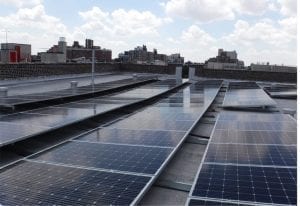
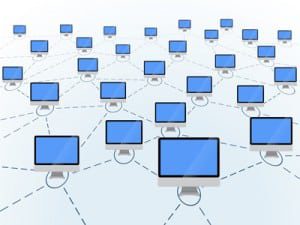




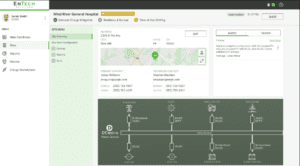
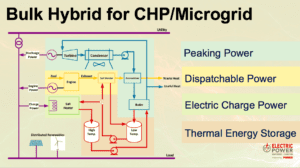
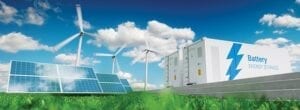

![Microgrid_Infographic[3]](https://www.powermag.com/wp-content/uploads/2017/08/fig-2_how-microgrids-work-300x162.jpg)



